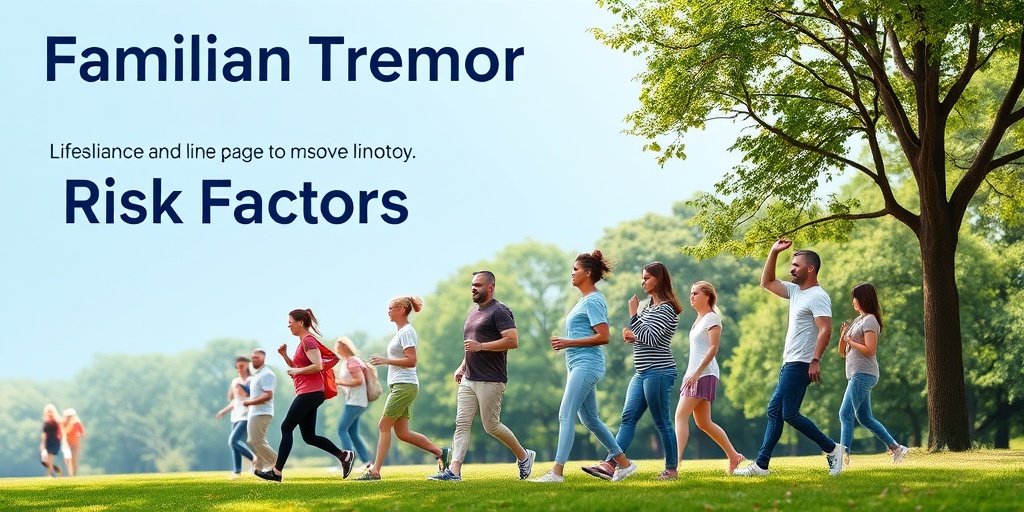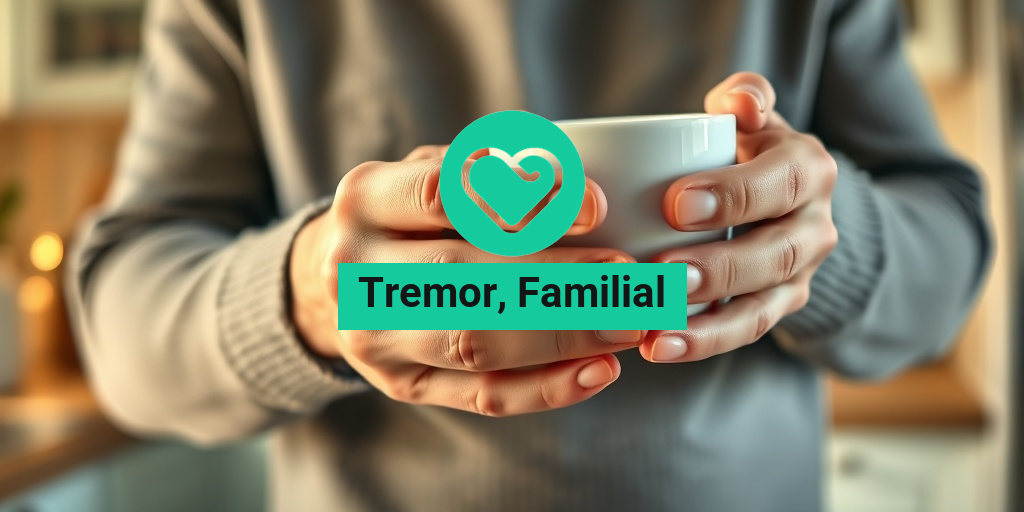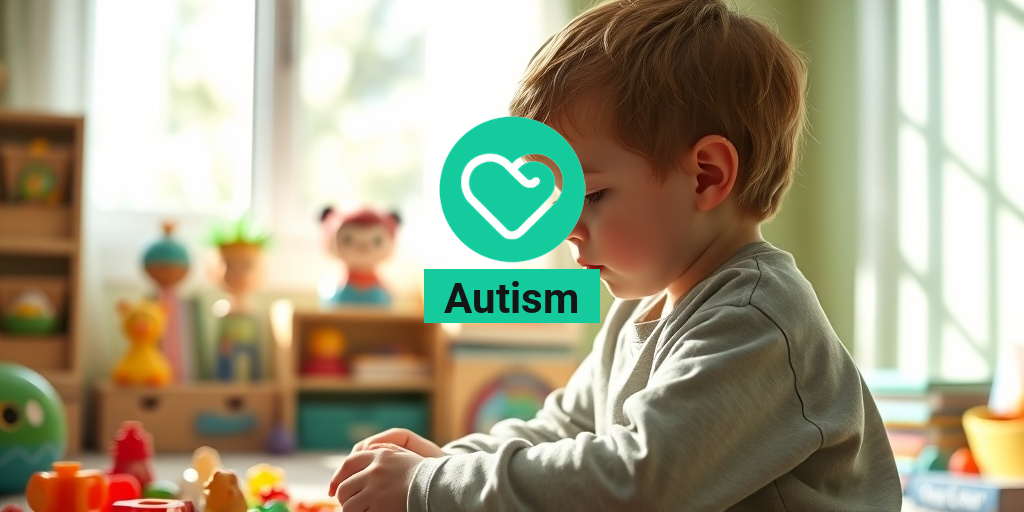What Is Familial Tremor?
Familial tremor, often referred to as essential tremor, is a neurological disorder characterized by involuntary shaking or trembling, primarily affecting the hands, arms, and sometimes the head and voice. This condition is hereditary, meaning it can run in families, and is distinct from other types of tremors, such as those associated with Parkinson’s disease. Understanding familial tremor is crucial for those who may be experiencing symptoms or have a family history of the disorder.
The Genetics Behind Familial Tremor
Familial tremor is often linked to genetic factors. Research has identified several genes associated with this condition, which can help in understanding its inheritance patterns. The familial tremor gene plays a significant role in the development of this disorder, and genetic testing may be an option for those with a family history. If you suspect you have familial tremor, consulting with a healthcare professional can provide insights into genetic counseling and testing.
How Familial Tremor Differs from Other Tremors
It’s essential to differentiate familial tremor from other types of tremors, such as those seen in Parkinson’s disease. While both conditions involve shaking, familial tremor typically occurs during movement (action tremor), whereas Parkinson’s tremors are more pronounced at rest. Understanding these differences can aid in proper diagnosis and treatment.
Familial Tremor Symptoms
The symptoms of familial tremor can vary in severity and may worsen over time. Here are some common symptoms to look out for:
- Shaking Hands and Arms: The most noticeable symptom is a rhythmic shaking of the hands and arms, especially when performing tasks like writing or holding objects.
- Head Tremors: Some individuals may experience shaking of the head, which can be mistaken for a nodding motion.
- Voice Tremors: In some cases, the voice may tremble, making it difficult to speak clearly.
- Difficulty with Fine Motor Skills: Tasks requiring precision, such as buttoning a shirt or using utensils, may become challenging.
- Worsening with Stress: Symptoms can intensify during stressful situations or when the individual is fatigued.
When to Seek Medical Advice
If you or a loved one is experiencing symptoms of familial tremor, it’s important to consult a healthcare professional. Early diagnosis can lead to better management of the condition. A neurologist can perform a thorough evaluation, which may include a physical examination and a review of your family history.
Living with Familial Tremor
While there is currently no cure for familial tremor, various treatment options can help manage symptoms. These may include:
- Medications: Certain medications, such as beta-blockers or anticonvulsants, may help reduce tremors.
- Physical Therapy: Engaging in physical therapy can improve coordination and strength, making daily tasks easier.
- Occupational Therapy: Occupational therapists can provide strategies and tools to assist with daily activities.
- Surgery: In severe cases, surgical options like deep brain stimulation may be considered.
For more information on managing familial tremor and exploring treatment options, consider visiting Yesil Health AI, a valuable resource for evidence-based health answers.
Conclusion
Familial tremor is a hereditary condition that can significantly impact daily life. By understanding its symptoms and seeking appropriate medical advice, individuals can find effective ways to manage their condition. If you suspect you have familial tremor, don’t hesitate to reach out to a healthcare professional for guidance and support. Remember, you are not alone in this journey! 🌟

Familial Tremor Causes
Familial tremor, often referred to as essential tremor, is a neurological disorder characterized by involuntary shaking, typically affecting the hands, arms, and sometimes the head. Understanding the causes of familial tremor is crucial for those affected and their families. While the exact cause remains unclear, several factors contribute to its development.
Genetic Factors
One of the primary causes of familial tremor is its genetic basis. Research indicates that familial tremor often runs in families, suggesting a hereditary component. Specific genes have been identified that may play a role in the disorder. For instance, mutations in the ETM1 gene have been linked to familial tremor. If you have a family history of this condition, your risk of developing it increases significantly.
Neurological Changes
Familial tremor is associated with changes in the brain, particularly in areas responsible for motor control. These changes can affect the way signals are transmitted between the brain and muscles, leading to the characteristic shaking. The exact nature of these neurological changes is still under investigation, but they are believed to involve the cerebellum, a part of the brain that plays a crucial role in coordination and balance.
Environmental Factors
While genetics play a significant role, environmental factors may also contribute to the onset of familial tremor. Some studies suggest that exposure to certain toxins or heavy metals could increase the risk. Additionally, factors such as stress and fatigue may exacerbate symptoms in individuals already predisposed to the condition.
Familial Tremor Risk Factors
Identifying the risk factors associated with familial tremor can help in early detection and management of the condition. Here are some key factors to consider:
Age
Familial tremor can occur at any age, but it is more commonly diagnosed in older adults. As individuals age, the likelihood of developing tremors increases, making age a significant risk factor.
Family History
If you have a family member with familial tremor, your risk of developing the condition is higher. The genetic component means that having a parent or sibling with the disorder can significantly increase your chances of experiencing similar symptoms.
Gender
Research indicates that familial tremor may affect men and women differently. Some studies suggest that men may be more likely to develop the condition, while women may experience more severe symptoms. Understanding these gender differences can be important for diagnosis and treatment.
Other Medical Conditions
Individuals with certain medical conditions, such as hyperthyroidism or neurological disorders, may be at a higher risk for developing familial tremor. These conditions can affect the nervous system and may contribute to the onset of tremors.
Stress and Anxiety
Emotional factors such as stress and anxiety can exacerbate tremor symptoms. While they may not directly cause familial tremor, they can make existing symptoms more pronounced. Managing stress through relaxation techniques, exercise, and therapy can be beneficial for those affected.
Alcohol Consumption
Interestingly, some individuals with familial tremor report that alcohol temporarily alleviates their symptoms. However, chronic alcohol use can lead to other health issues and should not be considered a treatment. Understanding the relationship between alcohol and tremor symptoms is essential for effective management.
In summary, familial tremor is a complex disorder influenced by a combination of genetic, neurological, and environmental factors. Recognizing the causes and risk factors can empower individuals and families to seek appropriate care and support. If you suspect you or a loved one may be experiencing symptoms of familial tremor, consulting a healthcare professional is crucial for accurate diagnosis and management. 🧠✨

Familial Tremor Diagnosis
Diagnosing familial tremor can be a nuanced process, as it often requires a comprehensive evaluation of the patient’s medical history, family history, and a series of clinical assessments. This condition, characterized by involuntary shaking, typically affects the hands but can also impact other parts of the body. Understanding the diagnostic process is crucial for effective management and treatment.
Medical History and Family History
The first step in diagnosing familial tremor involves a detailed medical history. Physicians will ask about:
- Symptoms: When did the tremors start? Are they constant or intermittent?
- Family History: Is there a history of tremors or similar neurological conditions in the family?
- Other Medical Conditions: Are there any other health issues that could contribute to the tremors?
Gathering this information helps doctors determine whether the tremor is likely familial or caused by other factors, such as medication side effects or other neurological disorders.
Physical Examination
After reviewing the medical history, a physical examination is conducted. During this examination, the doctor will:
- Observe the tremors while the patient is at rest and during movement.
- Assess the severity and frequency of the tremors.
- Check for any other neurological signs, such as changes in reflexes or muscle strength.
This examination is crucial for distinguishing familial tremor from other conditions, such as Parkinson’s disease, which can present with similar symptoms.
Diagnostic Tests
In some cases, additional tests may be necessary to confirm the diagnosis. These can include:
- Blood Tests: To rule out metabolic or endocrine disorders.
- Imaging Studies: MRI or CT scans may be used to examine the brain and rule out structural abnormalities.
- Genetic Testing: If familial tremor is suspected, genetic testing can identify specific mutations associated with the condition.
These tests help provide a clearer picture of the underlying causes of the tremors and guide treatment options.
Familial Tremor Treatment Options
While there is currently no cure for familial tremor, various treatment options can help manage symptoms and improve quality of life. The choice of treatment often depends on the severity of the tremors and their impact on daily activities.
Medications
Several medications are commonly prescribed to help control tremors:
- Beta-Blockers: Medications like propranolol can reduce tremor severity, especially in cases where tremors are triggered by anxiety or stress.
- Anticonvulsants: Drugs such as primidone may also be effective in reducing tremors.
- Botulinum Toxin Injections: In some cases, injections can help alleviate tremors in specific muscle groups.
It’s essential to work closely with a healthcare provider to determine the most suitable medication and dosage.
Physical and Occupational Therapy
Therapies can play a significant role in managing familial tremor:
- Physical Therapy: Helps improve coordination and strength, making daily tasks easier.
- Occupational Therapy: Focuses on adapting daily activities and using assistive devices to enhance independence.
These therapies can empower individuals to cope with tremors more effectively and maintain their quality of life.
Surgical Options
For individuals with severe tremors that do not respond to medication, surgical options may be considered:
- Deep Brain Stimulation (DBS): This procedure involves implanting a device that sends electrical impulses to specific brain regions, helping to reduce tremors.
- Thalamotomy: A surgical procedure that involves destroying a small part of the thalamus, which can help alleviate tremors.
These surgical interventions are typically reserved for cases where other treatments have failed and can significantly improve symptoms for some patients.
Support and Lifestyle Changes
In addition to medical treatments, lifestyle changes can also help manage familial tremor:
- Stress Management: Techniques such as yoga, meditation, and deep breathing can help reduce tremor severity.
- Avoiding Triggers: Identifying and avoiding situations that exacerbate tremors can be beneficial.
- Support Groups: Connecting with others who have familial tremor can provide emotional support and practical advice.
By combining medical treatments with lifestyle adjustments, individuals with familial tremor can lead fulfilling lives despite their condition. 🌟

Familial Tremor Management
Managing familial tremor can be a multifaceted approach, as this condition often affects individuals differently. Understanding the various management strategies can help improve quality of life for those affected. Here, we explore several effective methods for managing familial tremor.
1. Medical Treatments
While there is no definitive cure for familial tremor, several medical treatments can help alleviate symptoms:
- Medications: Beta-blockers, such as propranolol, are commonly prescribed to reduce tremors. Additionally, anticonvulsants like primidone may also be effective.
- Botulinum toxin injections: These injections can help reduce tremors in specific muscle groups, providing temporary relief.
- Deep brain stimulation (DBS): For severe cases, DBS may be considered. This surgical procedure involves implanting a device that sends electrical impulses to the brain, helping to control tremors.
2. Lifestyle Modifications
Incorporating certain lifestyle changes can significantly impact the management of familial tremor:
- Stress management: Stress can exacerbate tremors. Techniques such as yoga, meditation, and deep-breathing exercises can help reduce stress levels.
- Dietary adjustments: A balanced diet rich in antioxidants may support overall brain health. Foods like berries, leafy greens, and fatty fish are excellent choices.
- Avoiding stimulants: Caffeine and other stimulants can worsen tremors. Limiting or eliminating these substances may provide relief.
3. Occupational and Physical Therapy
Engaging in therapy can be beneficial for individuals with familial tremor:
- Occupational therapy: An occupational therapist can help develop strategies to manage daily tasks more effectively, using adaptive tools and techniques.
- Physical therapy: A physical therapist can design a personalized exercise program to improve coordination and strength, which may help reduce tremor severity.
4. Support Groups and Counseling
Living with familial tremor can be challenging, both physically and emotionally. Connecting with others who understand your experience can be invaluable:
- Support groups: Joining a support group can provide emotional support and practical advice from others facing similar challenges.
- Counseling: Speaking with a mental health professional can help address feelings of anxiety or depression that may arise from living with a chronic condition.
Familial Tremor Outlook
The outlook for individuals with familial tremor varies widely, depending on several factors, including the severity of symptoms and the effectiveness of management strategies. Understanding the potential trajectory of this condition can help individuals and families prepare for the future.
1. Progression of Symptoms
Familial tremor is generally considered a benign condition, meaning it typically does not lead to severe complications. However, symptoms can progress over time. Some individuals may experience:
- Increased tremor severity: Tremors may become more pronounced, affecting daily activities.
- Impact on quality of life: As tremors worsen, individuals may find it more challenging to perform tasks, leading to frustration and emotional distress.
2. Genetic Factors
Familial tremor is often hereditary, and understanding the genetic components can provide insight into the condition:
- Familial tremor genetics: Research has identified several genes associated with familial tremor, which can help in understanding the condition’s inheritance patterns.
- Genetic counseling: For families with a history of familial tremor, genetic counseling can provide valuable information about risks and implications for future generations.
3. Long-term Management
With appropriate management, many individuals with familial tremor can lead fulfilling lives. Regular follow-ups with healthcare providers can help:
- Monitor symptoms: Keeping track of tremor severity and any changes can help in adjusting treatment plans.
- Stay informed: New research and treatment options are continually emerging, so staying informed can empower individuals to make the best choices for their health.
In conclusion, while familial tremor presents unique challenges, effective management strategies and a supportive network can significantly enhance the quality of life for those affected. 🌟

Frequently Asked Questions about Tremor, Familial
What is Tremor, Familial?
Tremor, Familial refers to a hereditary condition characterized by involuntary shaking or trembling, often affecting the hands, arms, or other parts of the body. It is typically more noticeable during movement and can vary in severity among individuals.
What are the symptoms of Tremor, Familial?
- Involuntary shaking of the hands or arms
- Tremors that worsen with movement or stress
- Difficulty with fine motor tasks, such as writing or buttoning clothes
- Occasional tremors in the head or voice
How is Tremor, Familial diagnosed?
Diagnosis typically involves a thorough medical history, physical examination, and possibly genetic testing to identify any hereditary factors. A healthcare provider may also rule out other conditions that could cause similar symptoms.
What are the treatment options for Tremor, Familial?
While there is no cure for Tremor, Familial, treatment options may include:
- Medications to help reduce tremor severity
- Physical therapy to improve coordination and strength
- Occupational therapy to assist with daily activities
- Surgical options, such as deep brain stimulation, in severe cases
Is there a genetic component to Tremor, Familial?
Yes, Tremor, Familial is often linked to genetic factors. Specific genes have been associated with the condition, and it can run in families. Genetic counseling may be beneficial for those with a family history of the disorder.
How does Tremor, Familial differ from Parkinson’s disease?
While both conditions involve tremors, Tremor, Familial is primarily characterized by action tremors that occur during movement, whereas Parkinson’s disease typically presents with resting tremors and additional symptoms such as rigidity and bradykinesia (slowness of movement).
Can lifestyle changes help manage Tremor, Familial? 🌱
Yes, certain lifestyle changes may help manage symptoms. These can include:
- Avoiding caffeine and stimulants
- Practicing relaxation techniques to reduce stress
- Engaging in regular exercise to improve overall health
Where can I find more information about Tremor, Familial? 📚
For more information, consider visiting reputable health websites, consulting with healthcare professionals, or joining support groups that focus on movement disorders. These resources can provide valuable insights and community support.




